
Damselflies are flying insects of the suborder Zygoptera in the order Odonata. They are similar to dragonflies but are smaller and have slimmer bodies. Most species fold the wings along the body when at rest, unlike dragonflies which hold the wings flat and away from the body. Damselflies have existed since the Jurassic, and are found on every continent except Antarctica.
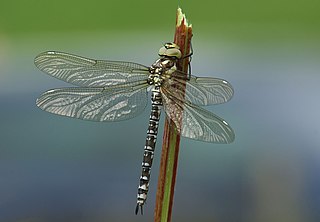
Aeshna, or the mosaic darners, is a genus of dragonflies from the family Aeshnidae. Species within this genus are generally known as "hawkers" or "darners".
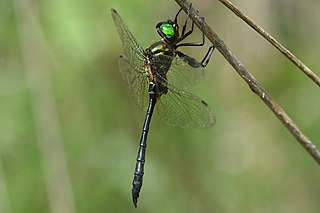
Corduliidae, also knowns as the emeralds, emerald dragonflies, or green-eyed skimmers, is a family of dragonflies. These dragonflies are usually black or dark brown with areas of metallic green or yellow, and most of them have large, emerald-green eyes. The larvae are black, hairy-looking, and usually semiaquatic. This family include species called "baskettails", "emeralds", "sundragons", "shadowdragons", and "boghaunters". They are not uncommon and are found nearly worldwide, but some individual species are quite rare. Hine's emerald dragonfly, for example, is an endangered species in the United States.

Pantala flavescens, the globe skimmer, globe wanderer or wandering glider, is a wide-ranging dragonfly of the family Libellulidae. This species and Pantala hymenaea, the "spot-winged glider", are the only members of the genus Pantala. It was first described by Johan Christian Fabricius in 1798. It is considered to be the most widespread dragonfly on the planet with good population on every continent except Antarctica although rare in Europe. Globe skimmers make an annual multigenerational journey of some 18,000 km ; to complete the migration, individual globe skimmers fly more than 6,000 km —one of the farthest known migrations of all insect species.

The Gomphidae are a family of dragonflies commonly referred to as clubtails or club-tailed dragonflies. The family contains about 90 genera and 900 species found across North and South America, Europe, Asia, Australia, and Africa. The name refers to the club-like widening of the end of the abdomen. However, this club is usually less pronounced in females and is entirely absent in some species.

Somatochlora, or the striped emeralds, is a genus of dragonflies in the family Corduliidae with 42 described species found across the Northern Hemisphere.

The incurvate emerald is a species of dragonfly in the family Corduliidae. It is found in Canada and the United States. Its natural habitat is fens.

Somatochlora sahlbergi, the treeline emerald, is a species of dragonfly in the family Corduliidae. It is found at high latitudes across northern Eurasia and North America, and occurs farther north than any other dragonfly.
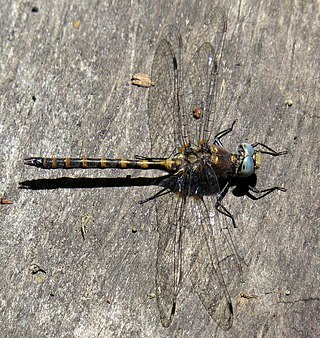
Williamsonia lintneri, the ringed boghaunter, is a species of dragonfly in the emerald family (Corduliidae). It is found at acid bogs in the northeastern United States and southeastern Canada.
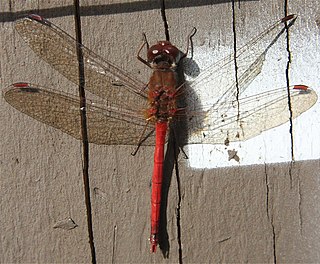
Sympetrum vicinum, the Yellow-Legged Meadowhawk is one of some fifteen North American species of autumn meadowhawk, which are members of the Odonate family Libellulidae. It grows to 26–35 mm long.

Sympecma fusca, the common winter damselfly, is a damselfly a member of the Lestidae and related to the emeralds or spreadwings.
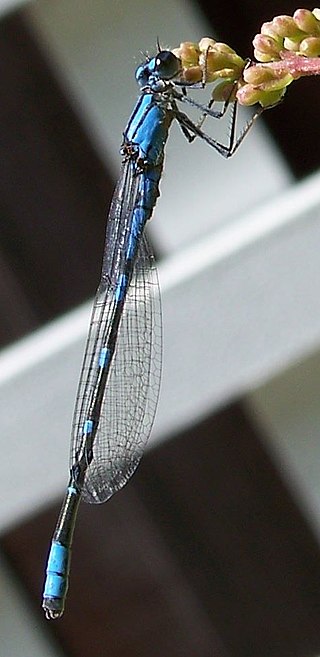
The tule bluet is a species of damselfly in the family Coenagrionidae found in North America, from northern Mexico to southern Canada.

Chalcolestes viridis, formerly Lestes viridis, is a damselfly of the family Lestidae. It has a metallic green body and at rest it holds its wings away from its body. Its common name is the willow emerald damselfly, the green emerald damselfly, or the western willow spreadwing. It has an elongated abdomen and pale brown spots on its wings and resides in areas of still water with overhanging trees.

Aeshna canadensis, the Canada darner, is a species of dragonfly in the family Aeshnidae. It is common throughout southern Canada and the northern United States.

Satyrium liparops, the striped hairstreak, is a butterfly of the family Lycaenidae described by John Eatton Le Conte in 1833. It is found in North America, from the Rocky Mountains south from southern Canada to Colorado, east to Maine and south to Florida.

Lestes elatus is a species of damselfly in the family Lestidae, the spreadwings. It is known commonly as the emerald spreadwing. It is native to India, Thailand and Sri Lanka.

Somatochlora ensigera, the plains emerald, is a species of dragonfly in the family Corduliidae. It is found in central North America.

Somatochlora septentrionalis, the muskeg emerald, is a species of dragonfly in the family Corduliidae. It is endemic to Canada, where it is found from Yukon and British Columbia east to Nova Scotia and Newfoundland.
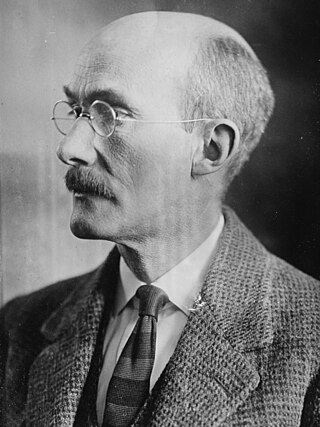
Reginald Heber Howe, Jr. was an American naturalist and preparatory school science teacher. His research specialized in the lichens, birds, and dragonflies. He founded the Belmont Hill School and served as its first headmaster.






















